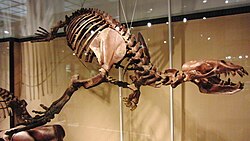| Allodesmus Temporal range: | |
|---|---|
 | |
| Skeleton of A. gracilis at the Natural History Museum of Los Angeles County | |
| Scientific classification | |
| Domain: | Eukaryota |
| Kingdom: | Animalia |
| Phylum: | Chordata |
| Class: | Mammalia |
| Order: | Carnivora |
| Parvorder: | Pinnipedia |
| Family: | † Desmatophocidae |
| Genus: | † Allodesmus Kellogg, 1922 |
| Species | |
| |
Allodesmus is an extinct genus of pinniped from the middle to late Miocene of California and Japan that belongs to the extinct pinniped family Desmatophocidae.





